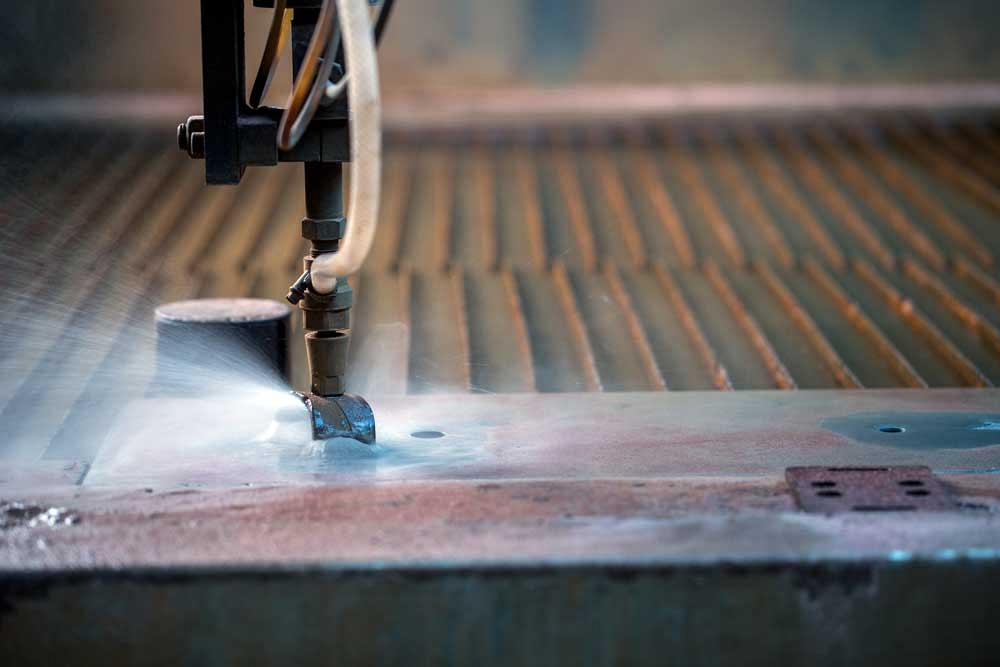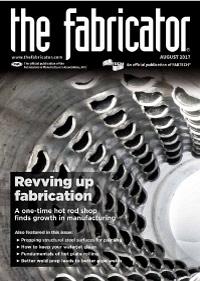Regional Sales Manager
- FMA
- The Fabricator
- FABTECH
- Canadian Metalworking
Categories
- Additive Manufacturing
- Aluminum Welding
- Arc Welding
- Assembly and Joining
- Automation and Robotics
- Bending and Forming
- Consumables
- Cutting and Weld Prep
- Electric Vehicles
- En Español
- Finishing
- Hydroforming
- Laser Cutting
- Laser Welding
- Machining
- Manufacturing Software
- Materials Handling
- Metals/Materials
- Oxyfuel Cutting
- Plasma Cutting
- Power Tools
- Punching and Other Holemaking
- Roll Forming
- Safety
- Sawing
- Shearing
- Shop Management
- Testing and Measuring
- Tube and Pipe Fabrication
- Tube and Pipe Production
- Waterjet Cutting
Industry Directory
Webcasts
Podcasts
FAB 40
Advertise
Subscribe
Account Login
Search
Lean and clean in waterjet cutting
These 7 tips can help a fabricator maintain a clean environment, even in the midst of a full production schedule
- By Ben Callahan
- August 4, 2017
- Article
- Waterjet Cutting
A lot of metal fabricating operations are cleaning up their act.
Some shops might be making a formal commitment to 5S practices. (5S is a workplace organization methodology based on Japanese principles that when translated all begin with the letter “S.” The rough translation is sort, set in order, shine, standardize, and sustain, all of which contribute to an environment where an individual does his job in the most efficient way possible.) This is most evident in shops that are committed to keeping the shop floor, walkways, and work areas clean of clutter. These shops want to “shine,” so they make accommodations for machine operators to tidy up their work areas each day.
Other metal fabricators simply appreciate an uncluttered work environment. Items such as tools are located easily in an organized environment. Clean floors pose less of a slip or tripping hazard. Also, cleanliness can be used as sales tool in trying to win over customers that are looking for a modern and reliable metal fabricating services provider.
The motivations are clear and easy to understand. The challenges are just as clear, particularly if a metal fabricator is operating a waterjet.
Everyone understands the benefits of waterjet cutting. It is suitable for cutting heat-sensitive material, eliminating the risk of introducing material stresses that typically come with thermal cutting of metal. It can cut a variety of material, such as glass and rubber, in addition to metal. It can hold an accuracy of 0.005 in. with a repeatability of 0.001 in. over the entire work envelope.
But it can be a messy process. When pulverized abrasive hits the water, you get what is best described as “muck,” which sometimes can kick back from the cuting process and land outside of the tank. Abrasive dust and the water from the tank also can escape, landing on anything that may be nearby. It’s one of the main reasons that fabricators keep laser cutting machines and high-end press brakes away from waterjet cutting activities.
Many metal fabricators just live with the messy byproducts that sometimes accompany the waterjet cutting process. But they should know that it doesn’t have to be that way.
These seven tips can help to keep a waterjet cutting area clean and turn it into a showplace work area.
No. 1. Put Shields Around the Tank
If you use a waterjet to cut metal, water spray is going to be kicked back at you. The jet might hit the top slats and produce the kickback, or the jet might hit the bottom of the slats and create a lot of turbulence, which will shoot some water over the tank’s edges.
Shields, which typically are 2 to 3 feet high and attach to the side of the tank walls, keep the spray in the tank. The shields usually are made of a clear plastic, such as LexanTM, but metal shielding is a money-saving alternative. You can either purchase shields or make them yourself.
Keep in mind that from an operator’s perspective, it’s definitely better to use transparent shields. It’s simply easier to see what’s going on inside of the tank. At the very least, the shielding near the control station should be clear.
If you don’t want to deal with shielding, you can take other steps. Welding curtains are always available in a fab shop, and they can do the trick in terms of keeping dust and water spray inside a certain area. Fabricators also have been known to string up shower curtains or some type of plastic tarp around the tank to accomplish the same goal.
No. 2. Consider Cutting Underwater
Cutting underwater is a great way to keep the cutting process as contained and clean as possible. The underwater piercing process still produces spray, but when the machine is running, not too much material is going to escape the tank. Underwater cutting also keeps the noise down.
Experienced waterjet operators likely want the cutting to take place above the water line just so they can see the cutting process easily. If you choose to cut underwater, make sure the job program is solid, so you don’t have to worry about issues such as tip-ups. When running a program for the first time, it is best not to run it as an underwater cutting job.
No. 3. Treat that Waterjet Tank Like a Car
At the end of the day, rinse off the machine and hose everything down. That keeps the muck that gets kicked out of tank and stuck on the tank from drying and becoming even more difficult to remove.
If possible, try rinsing down the tank in between jobs. Even filling up a bucket with some soap and using a broom or a scrub brush on the stick to wipe down the machine to keep it clean makes for a good use of time.
To help battle against future muck sticking to the tank, try spraying some car wax in the tank. With a simple application of wax, the surface finish should repel dirt and help bead up the water. If you want the water to stream off the treated surface, try using a more expensive wax.
No. 4. Use Just Water to the Cut, If Possible
For most sheet metal work, waterjet cutting requires abrasive. But if you are cutting materials that allow you to forego the use of abrasive, that eliminates worries about dust and muck.
It also reduces the amount of abrasive that is used, which is good news if you are looking to save some money.
No. 5. Run the Abrasive Removal System
Most shops run their waterjets until the tanks start to fill with muck, calling in a company to empty it only when absolutely necessary. After all, shops only get paid while the waterjet is producing parts.
An automated abrasive removal system allows the waterjet to run as long as it is cutting parts. The system keeps the tanks clean and reduces opportunities for the jet to kick water and muck out of the tank.
This type of system performs best if you run it constantly, because the jets at the bottom of the tank won’t get clogged with abrasives or dropped parts.
At the very least, if you only run your abrasive removal system occasionally, be sure to monitor the amount of abrasives that you put into the tank. That way you’ll know the best time to start pulling out the abrasive before excessive kick-back becomes a problem.
No. 6. Consider the Use of a Flood Nozzle
A flood nozzle creates a small curtain of water around the jet stream, which helps contain the kick-back.
When cutting glass or a polished material, the flood nozzle also helps with the frosting of the material’s edge once it is cut.
Fabricators also have used plastic or aluminum shields around the waterjet stream to help keep the mess in the tank. The use of a plunger head is also not out of the realm of possibility.
No. 7. Revisit How the Parts Are Programmed
If you truly are serious about eliminating kick-back, take a look at the programming of the cut path. For example, if a job doesn’t call for exquisite edge quality, the programmer could design tabs into the cutting program so that parts don’t come loose when they are cut. With that extra support, you could cut the parts without the use of slats in the waterjet. Without the slats, the waterjet stream isn’t likely to create a lot of kick-back. Of course, you will have to break the parts out, but you could do that in the time you usually would sped cleaning the tank area.
A job also can be refigured to start cuts on the edge of the material to prevent the splash that occurs with pierces in the middle of the material. The programmer also could have the waterjet cut continuously on a piece of sheet metal or plate to avoid the start and stops that churn up the water and create more kick-back.
About the Author
subscribe now

The Fabricator is North America's leading magazine for the metal forming and fabricating industry. The magazine delivers the news, technical articles, and case histories that enable fabricators to do their jobs more efficiently. The Fabricator has served the industry since 1970.
start your free subscription- Stay connected from anywhere

Easily access valuable industry resources now with full access to the digital edition of The Fabricator.

Easily access valuable industry resources now with full access to the digital edition of The Welder.

Easily access valuable industry resources now with full access to the digital edition of The Tube and Pipe Journal.
- Podcasting
- Podcast:
- The Fabricator Podcast
- Published:
- 04/30/2024
- Running Time:
- 53:00
Seth Feldman of Iowa-based Wertzbaugher Services joins The Fabricator Podcast to offer his take as a Gen Zer...
- Industry Events
Pipe and Tube Conference
- May 21 - 22, 2024
- Omaha, NE
World-Class Roll Forming Workshop
- June 5 - 6, 2024
- Louisville, KY
Advanced Laser Application Workshop
- June 25 - 27, 2024
- Novi, MI
Precision Press Brake Certificate Course
- July 31 - August 1, 2024
- Elgin,
































